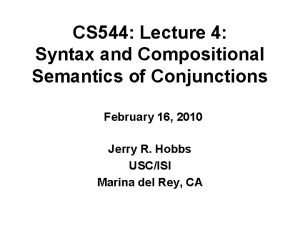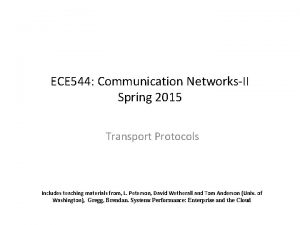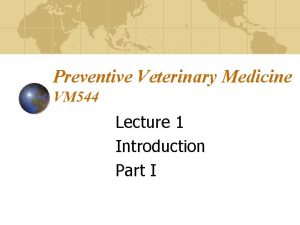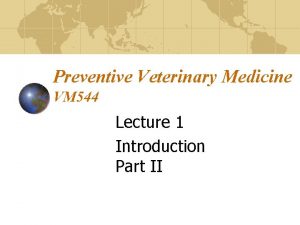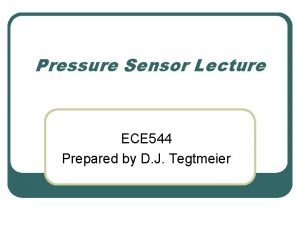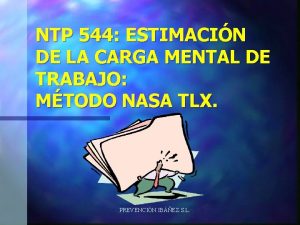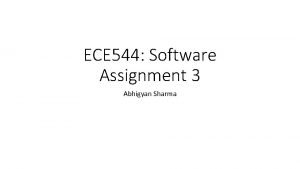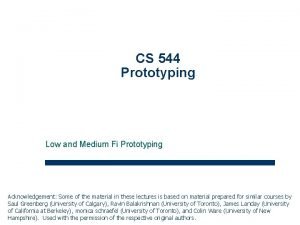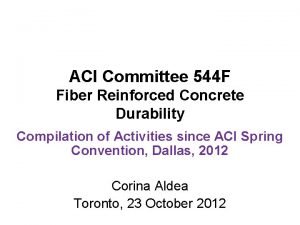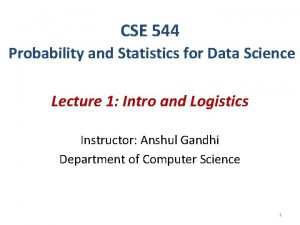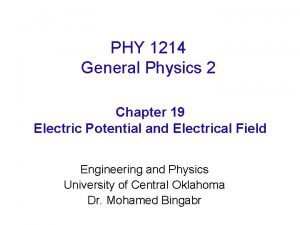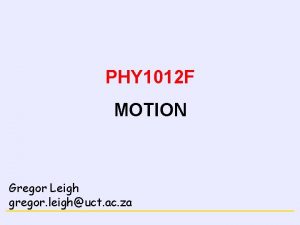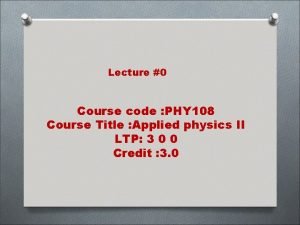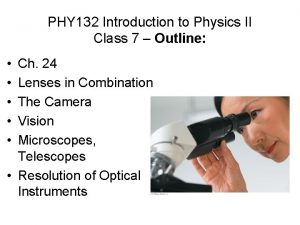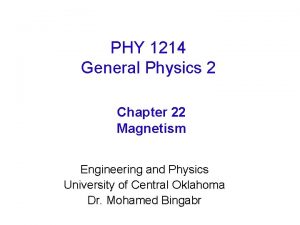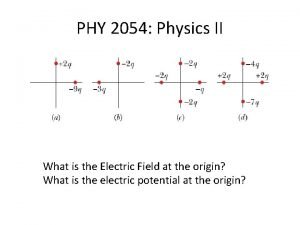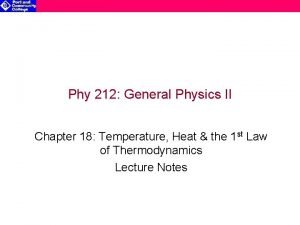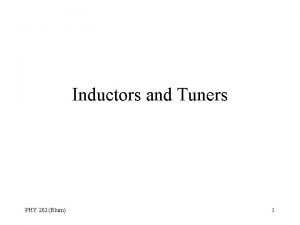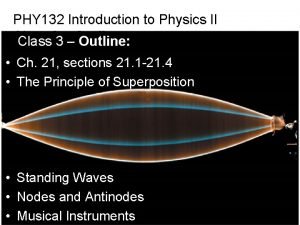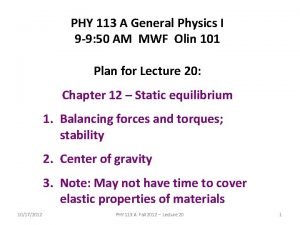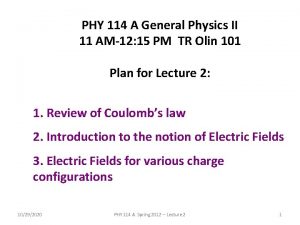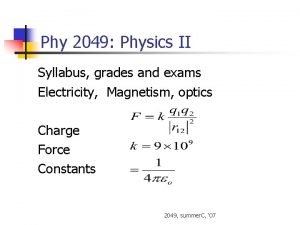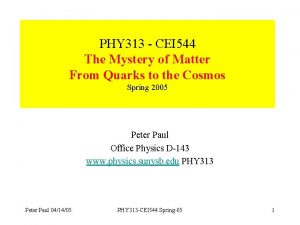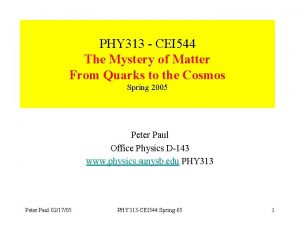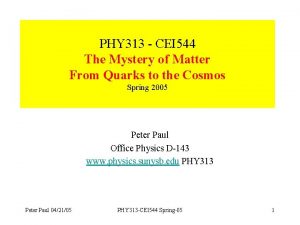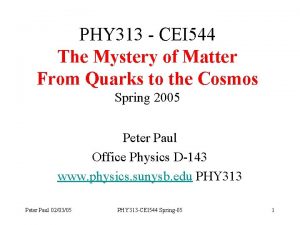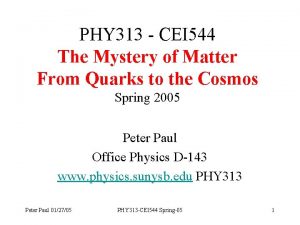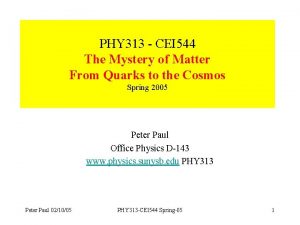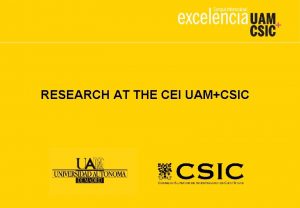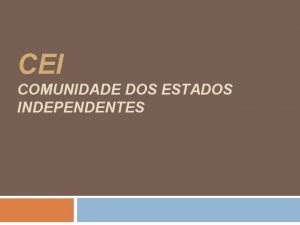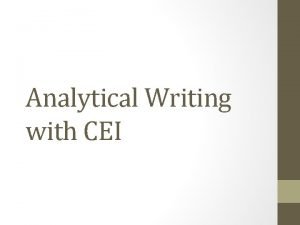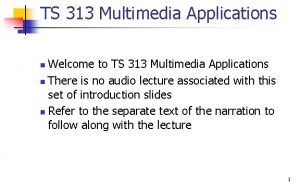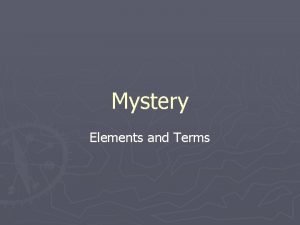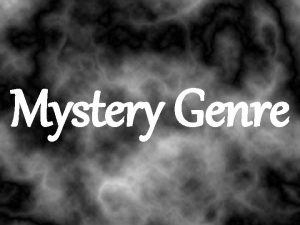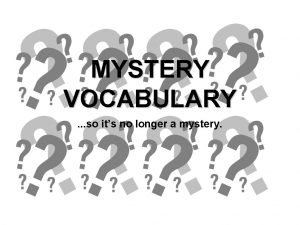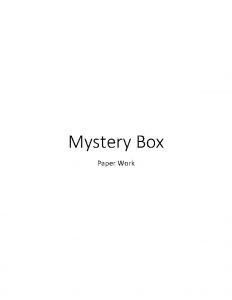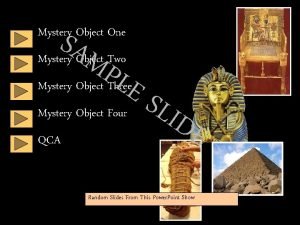PHY 313 CEI 544 The Mystery of Matter

































- Slides: 33

PHY 313 - CEI 544 The Mystery of Matter From Quarks to the Cosmos Spring 2005 Peter Paul Office Physics D-143 www. physics. sunysb. edu PHY 313 Peter Paul 04/7/05 PHY 313 -CEI 544 Spring-05 1

Class Performance Today • All Homework has been marked up and I have graded HW #7 myself. • I am returning all HW in my possession, old and new, today. All your HW is stapled together. • The Total Standing is written in red on each sheet. You can compare it to the “straw” grade assignments listen in the Table. • Please do not copy each other’s HW • Please read the questions carefully! • Please write legibly and staple multiple sheets together. Peter Paul 04/7/05 PHY 313 -CEI 544 Spring-05 D C B A 2

The particles of the Standard Model I • Six quarks are the “bricks” of the strongly interacting matter. They have mass. • They are grouped into three families or generations: In each family the top member has electric charge +2/3 e, the bottom member has -1/3 e. • All quarks have spin ½ hbar. • They interact strongly by exchanging gluons, which transfer “color” from one quark to another. • Because quarks are charged they interact electromagnetically with other charged particles by exchanging ’s. • Quarks can interact with through the weak interaction by exchanging W and Z 0 bosons. Peter Paul 04/7/05 PHY 313 -CEI 544 Spring-05 3

The particles of the Standard Model II • There are 3 equivalent families of leptons (“light particles”). • The top member in each family is a electrically neutral neutrino, the bottom member is a singly-charged light particle. • Leptons all have spin ½ hbar • Leptons interact with each other by exchanging W and Z 0 bosons. • Charged leptons interact with other charged particles by exchanging ’s. • The lepton families are strictly separated from each other and individually conserved: when we create a lepton in a given family we need to create an anti-lepton from the same family Peter Paul 04/7/05 PHY 313 -CEI 544 Spring-05 4

The Force Carriers of the Standard Model • There are force carriers associated with each of the three interactions: they all have spin 1 hbar. 1. The Gluons transmit the “color” of the strong interaction (“color charge”). There are 8 gluons which have no electric charge 2. The Photon mediates the EM interaction. It has no charge. 3. The W and Z bosons mediate the weak inter. Name Symbol Spin Rest mass Lifetime action They couple to h/2 Ge. V 10 -25 s leptons and quarks. Gluon g 1 0 4. Note: the carrier of the Photon 1 < 6 x 10 -25 stable gravitational force is still unknown. W-Boson W 1 80. 22 3. 2 Z-Boson Peter Paul 04/7/05 Z 0 PHY 313 -CEI 544 Spring-05 1 91. 19 2. 6 5

What have we learned last time • Quarks are bound together with a force that increases as we try to pull them apart (Confinement). There is never a solitary quark. • However, theory of the strong interaction, QCD, predicts quite reliably that during the first microsecond after the Big Bang, when the Universe had a temperature > 170 Me. V, quarks were free to roam around as a form of matter called the Quark-Gluon Plasma (QGP). • We can hope to recreate this state by smashing Gold (AU) nuclei together at ultra-relativistic speed. • This is done at the Relativistic Heavy Ion Collider (RHIC) Peter Paul 04/7/05 • Gold ions can be accelerated like all charged particles by injecting them into an electric field. • These can be D. D. field, like in your TV, or r. f. fields that are built up in resonators. • In a D. C. field particles can accelerated all the time, but in r. f. fields particles must be bunched to arrive at the electric field at a time of high amplitude and with the right polarity. • Resonators can accelerate particles in a straight-line arrangement (LINACs) or can be bend in circles by magnets to pass through the resonators many times (Synchrotrons). In a synchrotron the beam bunches go around synchronously (in-step) with the r. f. frequency PHY 313 -CEI 544 Spring-05 6

What have we learned II • The most powerful accelerators today are colliders; these are (mostly) synchrotrons that store energetic beam bunches that circle clockwise and counterclockwise colliding in the center of a (or more) large detector. • RHIC is a collider that can store any kind of ion beam, from protons to Gold. • Energetic charged particles can be detected by their ionization in gas or in solid materials. The ionization products (gas ions and electrons) are then detected on wires or small plates and the path of the original ionizing particle can be reconstructed. Peter Paul 04/7/05 • Usually the charged participles are deflected in a magnetic field inside the detector to determine the momentum (mass x velocity) and charge of the particle. • Gamma rays are detected by the electrons that they free up in a semiconductor • Neutrons are detected by the recoil protons produced in a plastic material that contains lots of hydrogen, or in gas detectors where the neutron produces charged particles in a nuclear reaction. PHY 313 -CEI 544 Spring-05 7

The Force between quarks (QCD Potential) • In vacuum the potential shows – strong attractive force at short distance between quarks – linear increase with distance from color charge – confinement of quarks to hadrons: baryons (qqq) and mesons (qqbar) : – This is a consequence of the fact that gluons carry color. • in dense and hot matter – screening of color charges makes potential vanish for large distance – deconfinement of quarks QGP Peter Paul 04/7/05 PHY 313 -CEI 544 Spring-05 + +… 8

Required conditions to study quark gluon plasma Karsch, Laermann, Peikert ‘ 99 ~15% from ideal gas of weakly interacting quarks & gluons e/T 4 T/Tc Tc ~ 170 ± 10 Me. V (1012 °K) e ~ 3 Ge. V/fm 3 Peter Paul 04/7/05 PHY 313 -CEI 544 Spring-05 9

Evolution of the Universe Too hot for quarks to bind!!! 1012 K Standard Model (N/P) Physics Quark. Gluon Plasma? ? Too hot for nuclei to bind 1010 K Nuclear/Particle (N/P) Physics Hadron Gas Nucleosynthesis builds nuclei up to He Nuclear Force…Nuclear Physics Universe too hot for electrons to bind E/M Plasma E-M…Atomic (Plasma) Physics 104 K Solid Liquid Gravity…Newtonian/General Relativity Gas Today’s Cold Universe Peter Paul 04/7/05 PHY 313 -CEI 544 Spring-05 10

Schematic View of a Heavy Ion Collision b~0 projectile p J/ p several 1000 particles produced in central collision target K p cc p p e- e p p + • hadrons such as , K, p - lots, produced “late” when particles stop to interact (freeze-out) • electro-magnetic radiation , e+e-, m+m- -few, emitted “any time”; http: //www. bnl. gov/heavy_ion. htm Peter Paul 04/7/05 PHY 313 -CEI 544 Spring-05 11

Properties of a plasma • 4 th state of matter (after solid, liquid and gas) • a plasma is: – ionized gas which is macroscopically neutral but has electrons and ions floating around independently – exhibits collective effects • interactions among charges of multiple particles – spreads charge out into characteristic (Debye) length, l. D – multiple particles inside this length – plasma size > l. D • “normal” plasmas are electromagnetic: electrons and ions – quark-gluon plasma interacts via strong interaction • color forces rather than EM • exchanged particles: g instead of Peter Paul 04/7/05 PHY 313 -CEI 544 Spring-05 12

You have seen the experiments STAR specialty: large acceptance measurement of hadrons Peter Paul 04/7/05 PHENIX specialty: rare probes, leptons, and photons PHY 313 -CEI 544 Spring-05 13

At what temperature does quark matter freeze out Assume all particle production described by a temperature T and a (baryon) chemical potential m : dn ~ e -(E-m)/T d 3 p One ratio (e. g. , pbar/p ) determines m / T : Second ratio (e. g. , K / ) provides T m; predict others Tf ~ 175 Me. V Peter Paul 04/7/05 PHY 313 -CEI 544 Spring-05 14

Approaching the Early Universe • Early Universe: The hot early universe contained equal numbers of particles and anti-particles l We’ve created “pure” matter approaching this value pbar/p – Anti-proton/proton = 0. 99999 l RHIC NA 44 Pb+Pb E 866 Au+Au Beam Energy (Ge. V) Peter Paul 04/7/05 PHY 313 -CEI 544 Spring-05 √s [Ge. V] 15

How to actively probe the deep interior? • Particles that come out with much energy perpendicular to the incoming beam directing must have strongly interacted in the medium: high p. T events. • Particles that come out with a shallow angle relative to the beam direction did had only feeble interaction. • Note: the large number of particles indicate that this reaction is a “direct hit”. Peter Paul 04/7/05 p p. T Beam 2 Beam 1 PHY 313 -CEI 544 Spring-05 16

Hadrons are stopped in hot matter peripheral Ncoll = 12. 3 4. 0 Peter Paul 04/7/05 central Ncoll = 975 94 PHY 313 -CEI 544 Spring-05 17

Photons come from the inside, Pions don’t • Direct photons are not inhibited by hot/dense medium Peter Paul 04/7/05 PHY 313 -CEI 544 • Pions (all hadrons) are inhibited by Spring-05 hot/dense medium 18

What conditions have been created? • The calibrated probes allow (rough) determination of the density formed in these collisions: – Energy Density ~ 15 Ge. V / fm 3 ~ 100 normal nuclear density – This is 5 x more than what was thought necessary to produce QGP – Mass Density ~ 2. 5 x 1016 gm / cm 3 • T > 170 Me. V ~ 2 x 1012 K – This is above the transition temperature of the QGP phase transition Æ The highest temperatures and densities ever formed in laboratory experiments Æ Conditions found in the first few microseconds of the Early Universe Peter Paul 04/7/05 PHY 313 -CEI 544 Spring-05 19

Collective motion called “elliptic flow” Origin: spatial anisotropy of the system when created, followed by multiple scattering of particles in the evolving system spatial anisotropy momentum anisotropy v 2: 2 nd harmonic Fourier coefficient in azimuthal distribution of particles with respect to the reaction plane Almond shape overlap region in coordinate space Peter Paul 04/7/05 PHY 313 -CEI 544 Spring-05 20

The data show the shape of the original collision Particle emission really is azimuthally anisotropic PHOBOS Peter Paul 04/7/05 Magnitude of the anisotropy grows with beam energy, then flattens PHY 313 -CEI 544 Spring-05 21 c. m. beam energy

Conservation laws • A physical quantity is “conserved” if it remains unchanged during a reaction, transformation or decay. • Conservation laws imply that a higher principle is at work • Conserved quantities that we already encountered: 1. Total Energy 2. Momentum 3. Angular momentum 4. Electric Charge 5. Baryon Number 6. Lepton Number 7. Strangeness Peter Paul 04/7/05 • The most fundamental Conservation Laws stem from the assumption that physical equations should be independent of the system in which they are observed. e. g. • Equations should be invariant to Lorentz transformation Translational transformation Rotational transformation Gauge invariance Implicit in the Standard Model PHY 313 -CEI 544 Spring-05 22

Conservation laws in beta decay • • • Energy Conservation Angular momentum conservation Charge conservation Baryon number conservation Lepton conservation • Please note : When the d quark changes into a u quark by producing a W Boson the quark color is preserved. Thus I have drawn the d & u arrows in the same color. • It was noted by a smart student in class that the W cannot carry away color and the color must be preserved. Peter Paul 04/7/05 d PHY 313 -CEI 544 Spring-05 u Feynman diagram We 23

Symmetries of shapes and bodies • If a shape or body is turned or changed in some operation and afterwards looks the same as before, the body is symmetric under that operation. • Similarly, physical equations can have symmetries. In fact the most elegant and basic equations derive their beauty and perhaps their insightfulness from their symmetry. http: //www. ctms. nist. gov/wulffman. html A sphere like Earth is symmetric for rotations around any axis – unless we look at the details on the surface A box has symmetries for rotations by 90 degrees to any surface Peter Paul 04/7/05 PHY 313 -CEI 544 Spring-05 24

Symmetries of simple shapes This triangle is symmetric to rotations by 600 or reflection by 1800 around the red axis This triangle is only symmetric to 1800 reflection around the red axis: less symmetric Peter Paul 04/7/05 PHY 313 -CEI 544 Spring-05 This football is rotational symmetric around the vertical (red) axis, but not the brown axis Find the symmetries of this body in the plane of the page 25

Nature’s Symmetry and Violations Snowflakes, like other crystals display beautiful symmetries. The human body is largely left-right symmetric in appearance. The human hands are symmetric in respect to leftright reflection Peter Paul 04/7/05 All proteins turn out to be twisted in only one direction: lefthanded. This is because all functioning aminoacids are left-handed. Right-handed aminoacids and proteins can be made on the bench but they are not leading to functioning proteins. This puzzled already Louis Pasteur. (we will come back to this mystery) PHY 313 -CEI 544 Spring-05 26

Mirror Symmetry • The Parity operation P(1) in one dimension flips the shape of an object into its mirror image: If P(1) operates on an arrow it will change it from a right arrow to a left arrow Mirror plane Real object Mirrored object • Mirror reflection changes a righthanded screw into a left-handed screw http: //www. phy. ntnu. edu/java/optics/mi rror_e. html Peter Paul 04/7/05 The Laws of Nature should not depend on whether we live in a right-handed or a left-handed world. It should not matter whether we look at the real object or its picture image. C. N. Yang and T. D. Lee proposed that this statement was wrong for the weak interaction PHY 313 -CEI 544 Spring-05 Which is the real picture? 27

The Parity Operation • The full parity operation reflects a 3 - P • Shape (x, y, z) = Shape (-x, -y, -z) dimensional object around each direction: the x-axis, the y-axis and the z z -axis. Thus we use 3 mirrors, one for each reflection. y • The operation P(x) reflects with a mirror P(x) that lies in the y-z plane. x • The operation P(y) reflects with a mirror that lies in the x-z plane • The operation P(z) reflects with a P(y) mirror that lies in the x-y plane. • Note: After the first reflection the rotation marker changes direction, but the arrow stays upright. After 3 reflections the rotation has its original P(z) sense back but the arrow is inverted. Peter Paul 04/7/05 PHY 313 -CEI 544 Spring-05 28

Parity violation in the weak interaction • Parity conservation was first tested in the beta decay of 60 Co: • The Co nuclei can be aligned by orienting their spins upwards in a magnetic field. Suppose the electrons are emitted preferentially downward (in the real world), i. e. opposite to the spin direction. • In the mirror world the spin direction faces downward. The beta rays will still come out downwards. Thus they would now come out in the same direction as the spin. Peter Paul 04/7/05 PHY 313 -CEI 544 Spring-05 29

Wu’s experiment • The only way that the mirror image could NOT be differentiated from the real world is with electrons coming out equally in the upward and the downward direction. • But Mrs. Wu et al observed that the electrons came out preferentially up or down. Thus Parity was NOT conserved. • Nuclear polarisation through spin alignment in a large magnetic field at 0. 01 o. K. At low temperature thermal motion does not destroy the alignment. Beta particles from 60 Co decay were detected by a thin scintillator placed above the 60 Co source. • Flipping the magnetic field flips the 60 Co spin direction, thus producing the mirror situation. Peter Paul 04/7/05 PHY 313 -CEI 544 Spring-05 30

Wu’s results • Top and middle graph - gamma anisotropy (difference in counting rate between two Na. I crystals) shows control of polarization; • Bottom - b asymmetry - counting rate in the anthracene crystal relative to the rate without polarization (after the set up was warmed up) for two orientations of magnetic field. • Similar behavior of gamma anisotropy and beta asymmetry. • Rate was different for the two magnetic field orientations indicating that Parity symmetry was violated. Peter Paul 04/7/05 PHY 313 -CEI 544 Spring-05 31

Particles & Antiparticles: The Dirac Equation • Starting ~ 1930 Dirac extended quantum mechanics to include Special Relativity. • Einstein had written: • With spin-1/2 electrons , e. g. can never stand still and thus p is never zero. • If we solve for E we obtain • What does the sign possibility mean ? Peter Paul 04/7/05 • Can Energy ever be negative? • Lifting an electron from a sea of bound particles leaves behind a positive hole: Positron. +E e- Paul M. Dirac Free particles -E PHY 313 -CEI 544 Spring-05 e+ Bound particles 32

Ninth Homework Set, due April 14, 2005 1. Describe briefly the various distinct stages of the evolution of the Universe as it cooled down after the Big Bang. 2. How does the Relativistic Heavy Ion Collider (RHIC) reproduce the conditions of the Universe when quarks were “deconfined”. For how long a time period can experiment hope to recreate this early universe? 3. What experimental evidence shows that experiment has succeeded in recreating these conditions? Explain one piece briefly. (Hint: consider how long it takes for a relativistic quark to fly through the hot nuclear volume!) 4. How can we understand the Baryon Conservation in terms of the quark model. Use the example of the beta decay of the proton. 5. Are the human hands mirror symmetric? Do the experiment with a mirror! 6. Describe the symmetries of the rectangle shown in slide 28, in two dimensions (i. e. in the plane of the paper). Peter Paul 04/7/05 PHY 313 -CEI 544 Spring-05 33
 Cs 544
Cs 544 2505447600
2505447600 Tcp
Tcp Vm 544
Vm 544 Vm 544
Vm 544 Ece 544
Ece 544 Ntp carga mental
Ntp carga mental Ece 544
Ece 544 Cs 544
Cs 544 Aci committee 544
Aci committee 544 Cse 544 sbu
Cse 544 sbu Phy 1214
Phy 1214 Phy
Phy Physics 2
Physics 2 Phy theorem
Phy theorem Phy 108
Phy 108 Phy 132 lecture 10: ch30
Phy 132 lecture 10: ch30 Phy 221 msu
Phy 221 msu General physics
General physics Phy
Phy Phy 205
Phy 205 Phy 212
Phy 212 Phy 131 past papers
Phy 131 past papers Felix connects a wire coil to an ammeter
Felix connects a wire coil to an ammeter Phy
Phy Phy 113 past questions and answers
Phy 113 past questions and answers Phy 132
Phy 132 Phy tgen
Phy tgen 2012 phy
2012 phy Phy
Phy Phy 2049
Phy 2049 Eye accommodation
Eye accommodation General physics 1 measurements
General physics 1 measurements Phy 231 msu
Phy 231 msu
